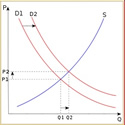

Economics and Benefits Analysis
The Society for Risk Analysis Economics and Benefits Analysis Specialty Group (EBASG) focuses on the use of economic analyses to support risk-management decisions. These analyses provide information on the costs, benefits, and other impacts of alternative approaches for reducing risks. Our goals include encouraging better integration between risk assessors, economists, and others involved in risk-management decisions, as well as enhancing the data and methods available for conducting economic analyses.

Economics and Benefits Analysis specialty group is co-sponsoring a webinar with Engineering and Infrastructure Specialty Group (EISG) on Decision-Making During A Syndemic: Evacuation and Sheltering in Response to Hurricane Laura
In August 2020, Hurricane Laura made landfall as a Category 4 storm, heavily affecting the coastlines of Texas and Louisiana. At the same time, both areas were coping with a surge in COVID-19 cases absent a vaccine. For this study, we explored how emergency management stakeholders navigated evacuation, sheltering, and re-entry planning and decision-making during a dual hazard threat where hurricane risk reduction measures contradicted COVID-19 risk reduction measures. We conducted 35 semi-structured interviews with emergency management stakeholders in Texas and Louisiana in the spring of 2021. Participants were recruited using a purposive sampling strategy designed to identify agency representatives and other officials involved in Hurricane Laura response. We used thematic analysis to code and analyze the data. Three themes emerged from the data. First, while the process for planning for hurricanes had to shift to an online approach, the plan for addressing hurricane season was largely unchanged from the perspective of most participants until days before impact when the decision was made to move to noncongregate sheltering. Second, emergency management stakeholders often described balancing the risks presented by COVID-19 and the hurricane as a series of trade-offs that they had to weigh, and households had to consider. Third, due to the shift to noncongregate sheltering and challenges presented by both COVID-19 and the hurricane, communicating with evacuees presented unanticipated challenges that required improvisation to address. Given the continued threat posed by COVID-19 and other respiratory illnesses, this study provides insights that emergency management stakeholders could apply to current and future planning and response efforts for hazards that require evacuation and sheltering.
REGISTER TODAY